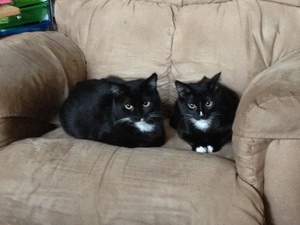Carl McColman: Lessons I've Learned from a Feral Cat
We first noticed feral kittens in our front yard last spring. At the time we just thought they were cute, and didn't try to interact with them -- like all undomesticated animals, they ran away if my wife or I walked anywhere near them. One was a grey tabby and the other almost all black. From time to time we'd see them streaking across the driveway as we walked to our cars.
Eventually the grey one disappeared. Feral cats have a short life expectancy, so we feared the worst. But one autumn day our hearts really sank -- the black kitten appeared with a litter of her own. Still barely a kitten herself, she had three little ones tagging along behind her.
We decided something needed to be done. A friend explained to us about "trap-neuter-return" which involves capturing the cats in a trap or carrier, having them "fixed" at a local vet who neuters feral animals for a minimal fee, and then releasing them back into the yard. Feral animals often cannot adapt to domesticated life, and some cats carry diseases like feline leukemia that would be dangerous for other cats. Nevertheless, we began to wonder if these cats might not have a future in our home -- and hearts.
So we set out to trap our little "neighbors" -- but before we could, two of the kittens disappeared, perhaps killed by dogs or coyotes. By setting out food and sitting quietly while they ate, we gradually won over the mama and lone kitten until one November night we trapped them both.
The next morning I took them to the vet, and asked not only to have them neutered, but tested for rabies and common feline diseases. They were both clean. So my wife and I decided to at least try to domesticate the cats, knowing that it would be a long and challenging process. We've had three rescue cats before, and while they tend to be timid, they also can be very affectionate. The worst scenario was that if they refused to adapt to indoor life, we'd just set them free at a later date.
After twelve weeks, we're thrilled at the progress we're making. The kitten (a boy we've named "Pete" after the children's book character) very quickly adapted to domestic life, proving to be not only friendly but affectionate. The mother (named Little Mama both for her petite size and youth) has been much more cautious. Predictably, she spent several days hiding under the bed, and would hiss every time my wife or I came close to her. Assuming this would require much patience, we took pains to avoid startling or frightening her, and to be generous both with food and "treats." Within days of her arrival, I began walking through my house with a gentleness and slowness almost like kinhin (walking meditation). Soon we began noticing progress.
At first, if I walked into a room where Little Mama was resting, she would immediately run and hide. After a while, she began to trust me enough to sit and watch (although quick to dart off if I moved too close). I noticed that she has her good days and bad days, and on the "good" days I could feed her treats, which she would hungrily take from my outstretched palm. Then she would accept being touched, gently and briefly. It felt like a breakthrough when she began to tolerate being petted (although even now, on a "bad" day she'll walk away if I try to touch her). More recently she has begun following me or my wife around the house -- classic domestic cat behavior. And this past weekend she joined us for an afternoon nap, sprawled across my legs while I rested.
There's still a ways to go -- after three months we still haven't picked her up (a necessary task, especially when her annual checkup with the vet rolls around), and she is nowhere close to Pete's regular habit of sitting in one of our laps while we read or watch television. But if the next six months go as well as the last three, we are optimistic about reaching these goals.
What has Little Mama taught me? The lessons may seem trite, but I'm a slow learner, and insights some people master in their youth I'm still working on as an adult. Love is more about giving than receiving. Calmness and tenderness can be conduits for healing. Patience is a virtue. It's okay to have good days and bad days, and "progress" means the good days get a little bit better. Walk slowly and gently. It's important to feel safe before you can play (when we first brought the feral cats indoors, they ignored our laser pointer, but now, just a few months later, Pete chases it exuberantly and even Little Mama will join the fun).
But perhaps the most interesting lesson Little Mama has taught me involves my relationship with God. I wanted to adopt her so I could pet her and love her, but I've had to patiently wait while she slowly overcame her shyness and fear of me. I'm twenty times bigger than her, so I understand she finds me scary! How honored I feel that she has slowly begun to trust me.
Isn't this a metaphor for how we humans relate to God? God wants to love us, but God is so much bigger than we are so we often feel afraid. And we run away, we do all we can to keep God at arm's length. But God is patient, and when we choose to trust God, we are met with unconditional love. And God is honored by our act of faith.
Follow Carl McColman on Twitter: www.twitter.com/CarlMcColman

